How to build a CI/CD pipeline for Serverless apps with CircleCI
At Seed, we’ve built a fully managed CI/CD pipeline for Serverless Framework apps on AWS. So you can imagine we have quite a bit of experience with the various CI/CD services.
Over the next few weeks we are going to dive into some of the most popular services out there. We’ll take a detailed look at what it takes to run your own CI/CD pipeline for Serverless apps. This’ll give you a good feel for not just how things work but how Seed makes your life easier!
Today we’ll be looking at CircleCI. You might have come across tutorials that help you set up a CI/CD pipeline for Serverless on Circle. However, most of these are way too simplistic and don’t talk about how to deploy large real-world Serverless apps.
Instead we’ll be working with a more accurate real-world setup comprising of:
- A monorepo Serverless app
- With multiple services
- Deployed to separate development and production AWS accounts
As a refresher, a monorepo Serverless app is one where multiple Serverless services are in subdirectories with their own serverless.yml file. Here is the repo of the app that we’ll be configuring you can refer to. The directory structure might look something like this:
/
package.json
services/
users-api/
package.json
serverless.yml
posts-api/
package.json
serverless.yml
cron-job/
package.json
serverless.yml
What we’ll be covering
- How to deploy your monorepo Serverless app on Git push
- How to deploy to multiple AWS accounts
- How to deploy using the pull request workflow
- How to clean up unused branches and closed pull requests
Note that, this guide is structured to work in standalone steps. If you only want to deploy to multiple AWS accounts, you can stop after step 2.
Also, worth mentioning that while this guide is helping you create a fully-functional CI/CD pipeline for Serverless; all of these features are available in Seed without any configuration or scripting.
Pre-requisites
- A CircleCI account.
- AWS credentials (Access Key Id and Secret Access Key) of the AWS account you are going to deploy to. Follow this guide to create one.
- A monorepo Serverless app in a GitHub repo. Head over to our template repo and click on Use this template to clone it to your account.
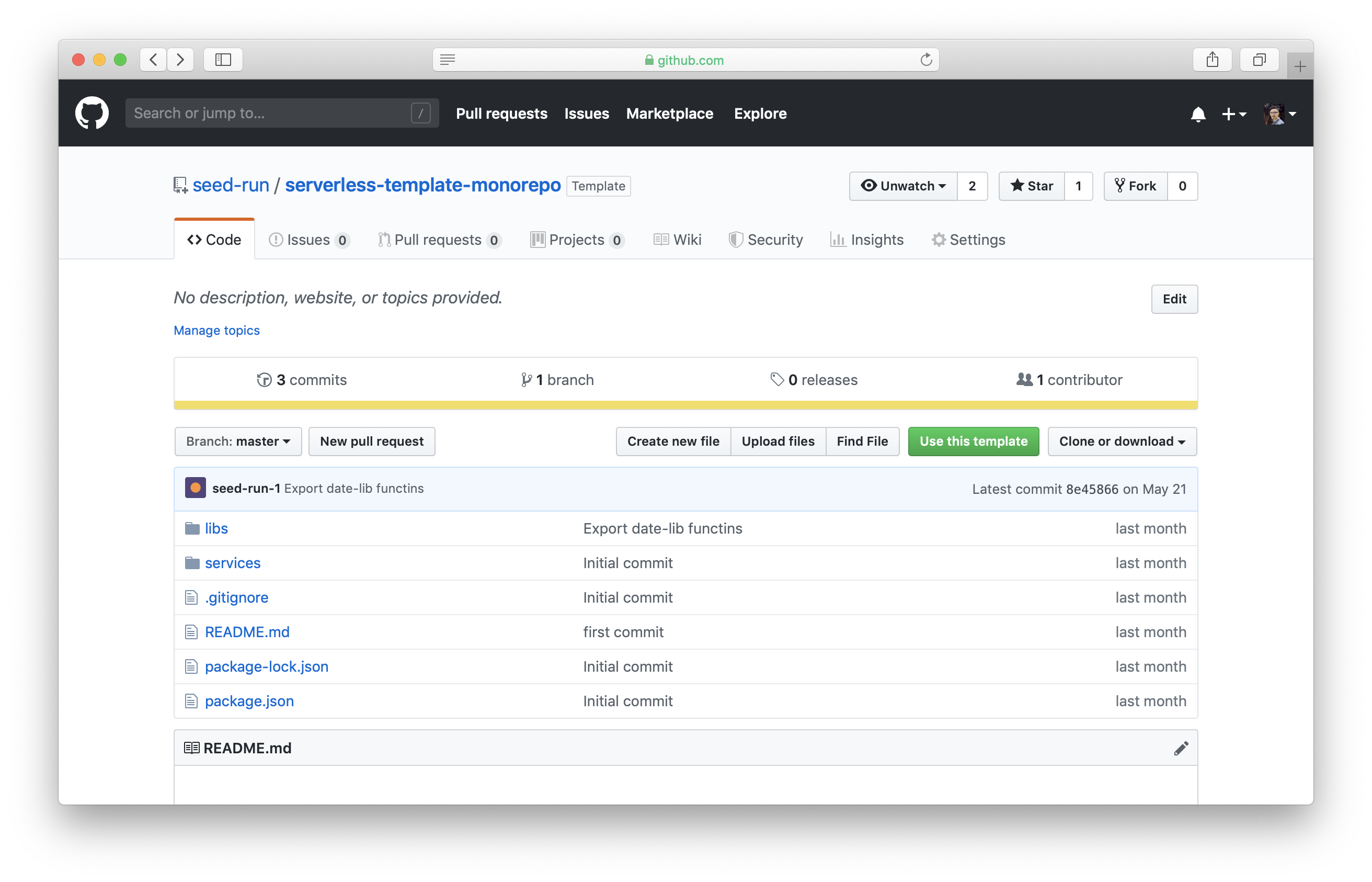
1. How to deploy your monorepo app on Git push
Let’s start by configuring the Circle side of things.
Go into your CircleCI account. Select Contexts from the left menu, and click Create Context.
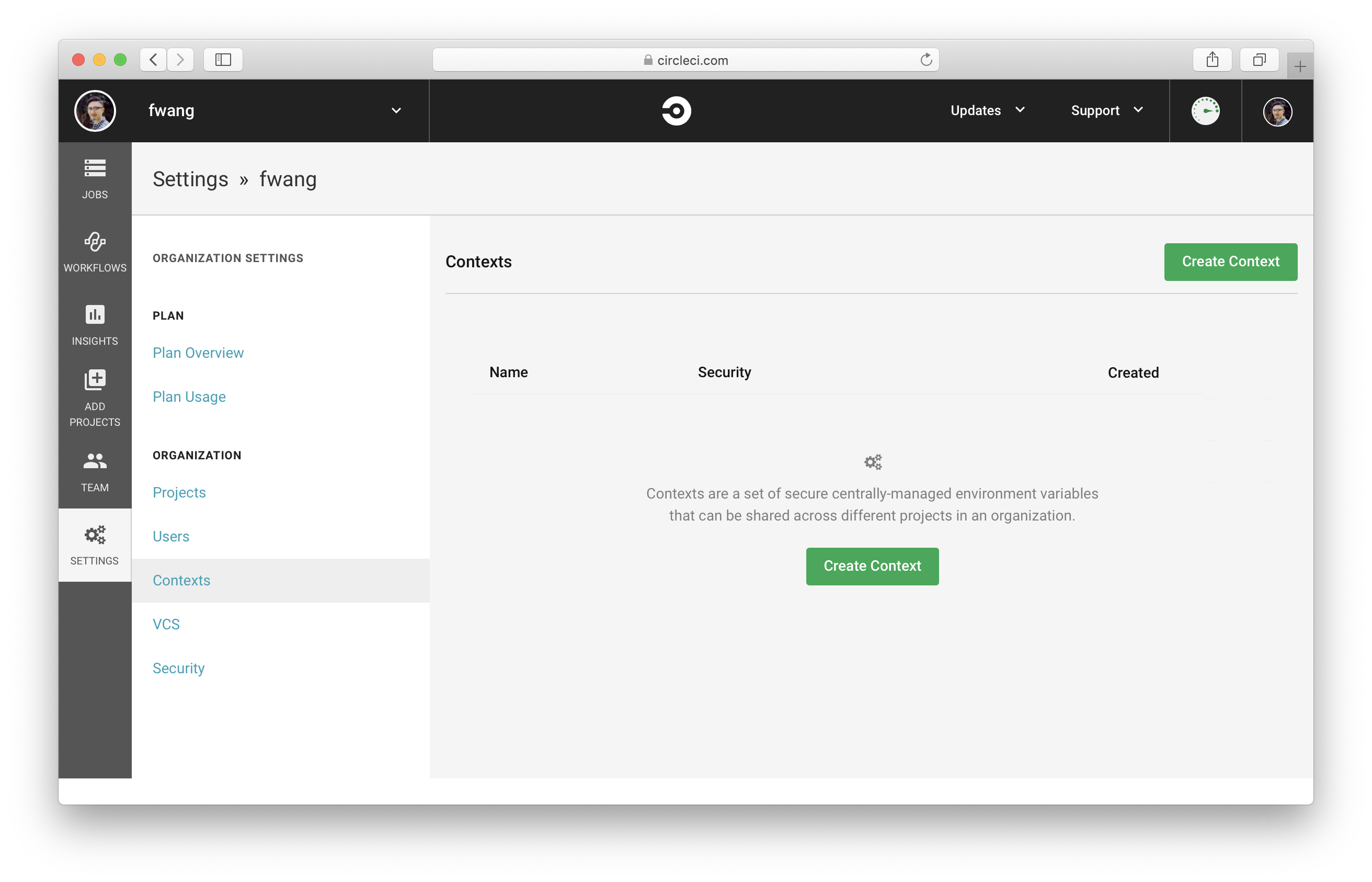
Create a context called Development.
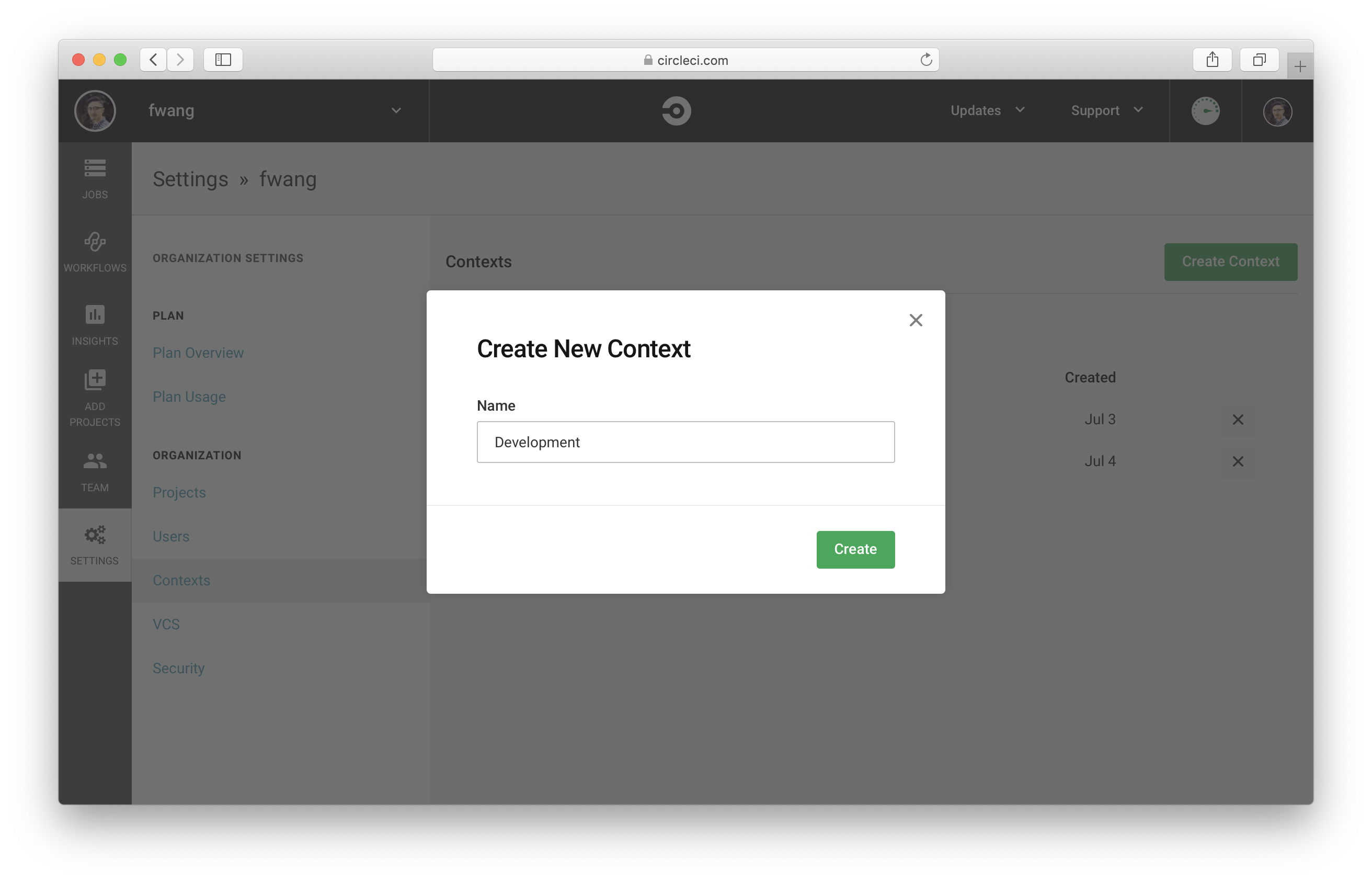
Go in to the Development context, and click on Add Environment Variable.
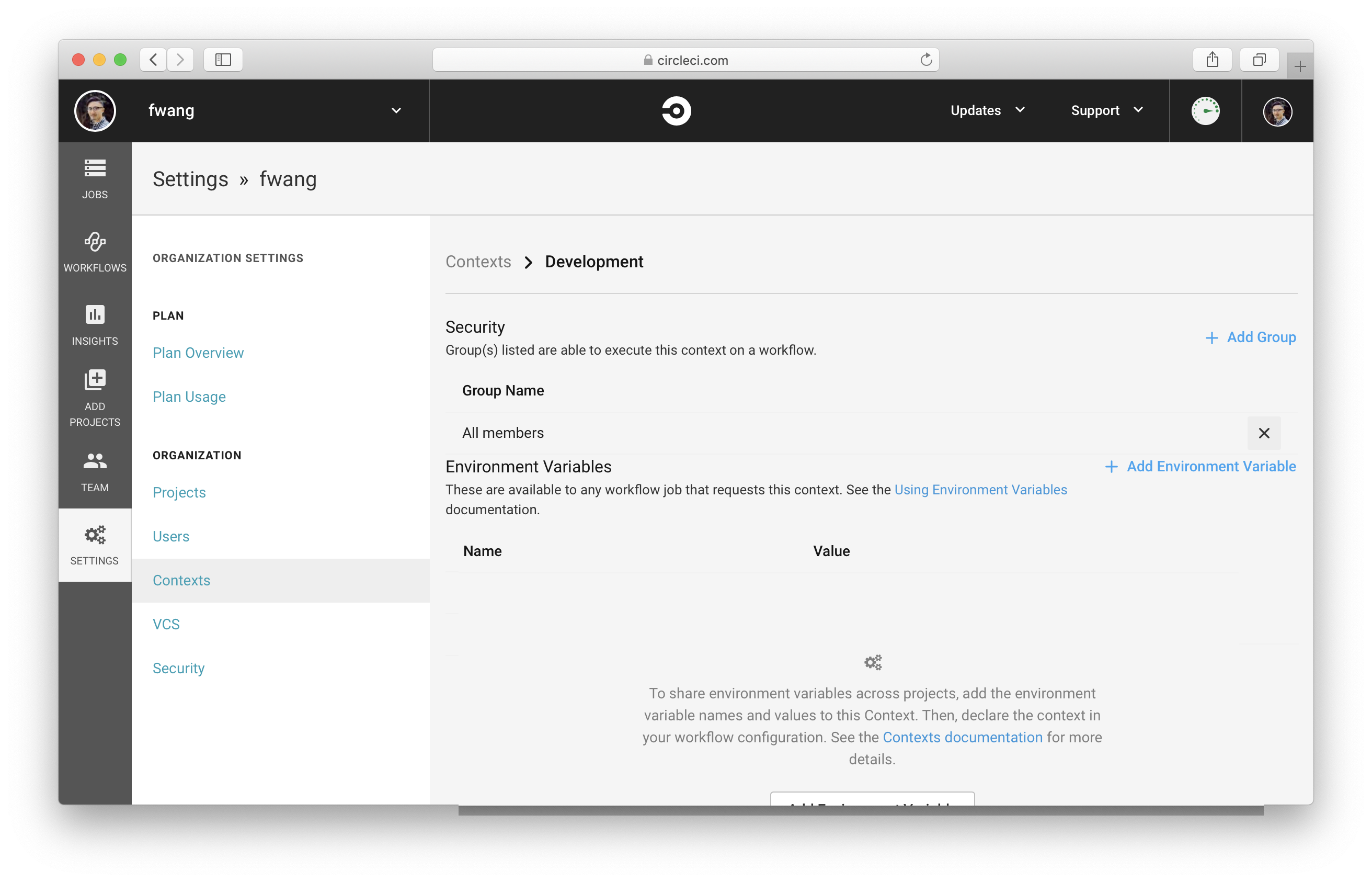
Create an variable with:
- Name: AWS_ACCESS_KEY_ID
- Value: Access Key Id of the IAM user
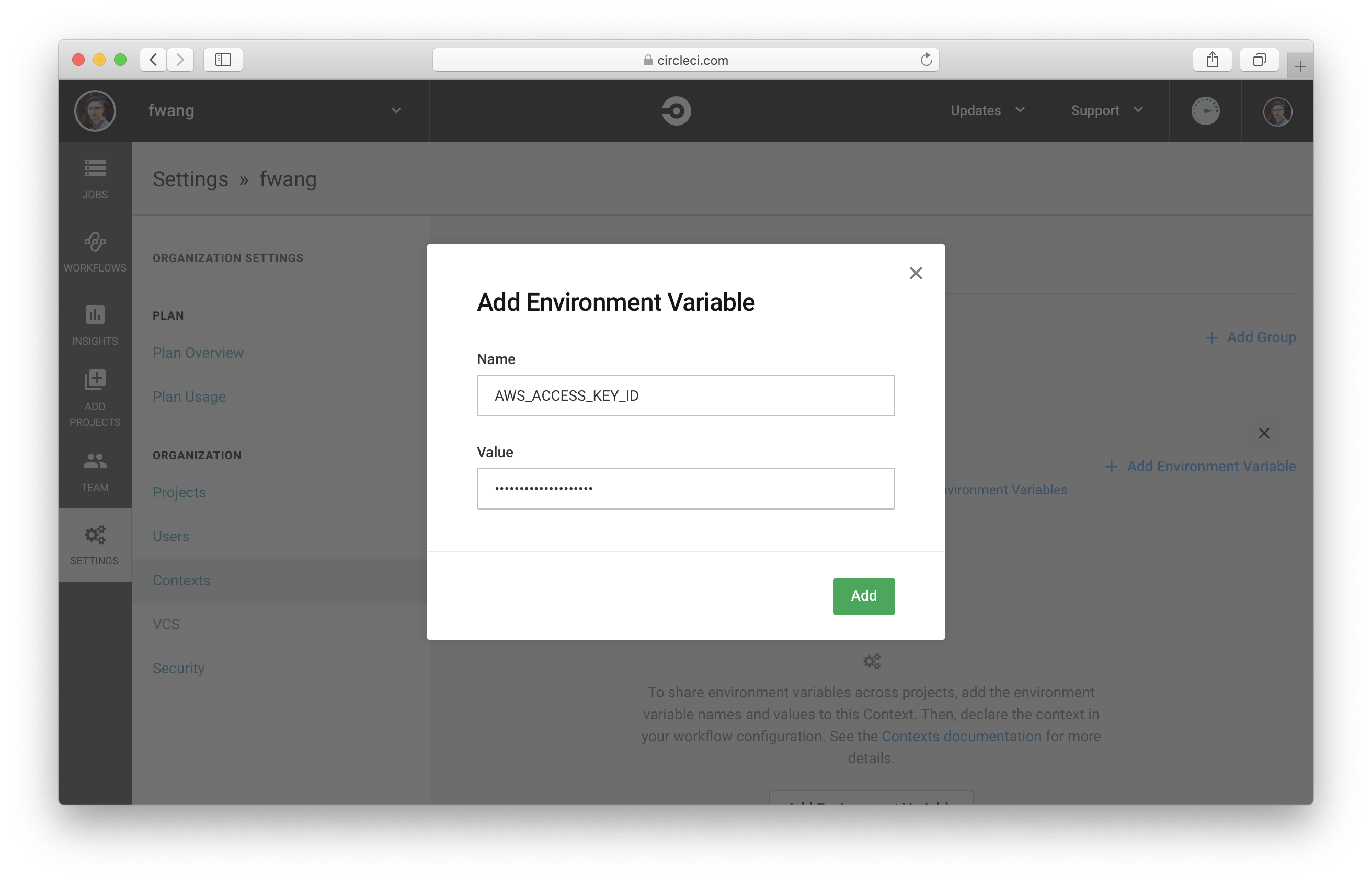
Repeat the previous step and create another variable with:
- Name: AWS_SECRET_ACCESS_KEY
- Value: Secret Access Key of the IAM user
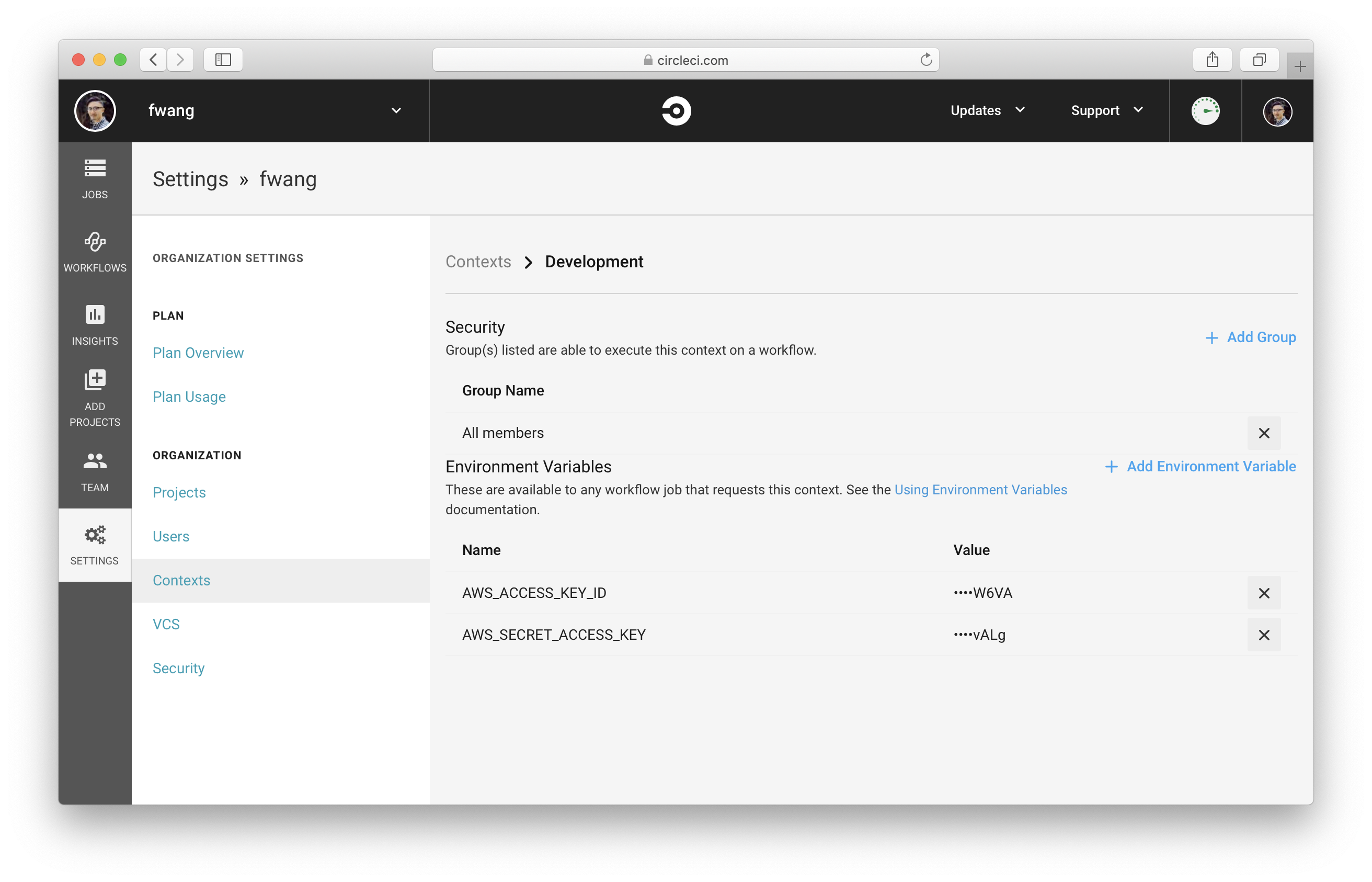
Go to the cloned repository and click on Create new file.
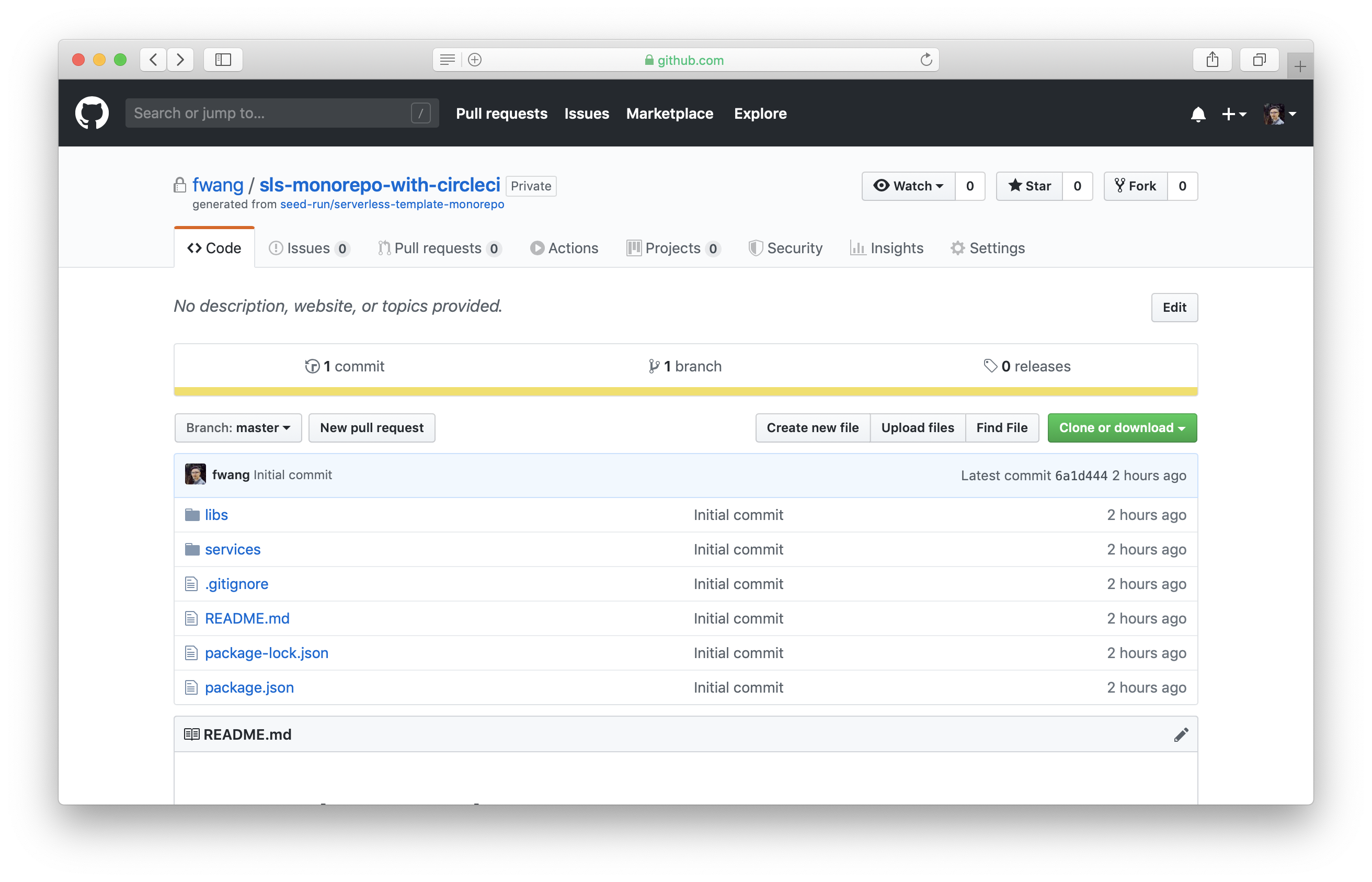
Name the new file .circleci/config.yml and paste the following:
version: 2.1
jobs:
deploy-service:
docker:
- image: circleci/node:8.10
parameters:
service_path:
type: string
stage_name:
type: string
steps:
- checkout
- restore_cache:
keys:
- dependencies-cache-{{ checksum "package-lock.json" }}-{{ checksum "<< parameters.service_path >>/package-lock.json" }}
- dependencies-cache
- run:
name: Install Serverless CLI
command: sudo npm i -g serverless
- run:
name: Install dependencies
command: |
npm install
cd << parameters.service_path >>
npm install
- run:
name: Deploy application
command: |
cd << parameters.service_path >>
serverless deploy -s << parameters.stage_name >>
- save_cache:
paths:
- node_modules
- << parameters.service_path >>/node_modules
key: dependencies-cache-{{ checksum "package-lock.json" }}-{{ checksum "<< parameters.service_path >>/package-lock.json" }}
workflows:
build-deploy:
jobs:
- deploy-service:
name: Deploy Users API
service_path: services/users-api
stage_name: ${CIRCLE_BRANCH}
context: Development
- deploy-service:
name: Deploy Posts API
service_path: services/posts-api
stage_name: ${CIRCLE_BRANCH}
context: Development
- deploy-service:
name: Deploy Cron Job
service_path: services/cron-job
stage_name: ${CIRCLE_BRANCH}
context: Development
Let’s quickly go over what we are doing here:
- We created a job called deploy-service, that takes the path of a service and the name of the stage you want to deploy to. The name of the stage will be used as the
--stagein the Serverless commands. - The deploy-service job does an
npm installin the repo’s root directory and in the service subdirectory. - The job then goes into the service directory and runs
serverless deploywith the stage name that’s passed in. - We also created a workflow that runs the deploy-service job for each service, while passing in the branch name as the stage name.
- As a side note, we also specified that we want to cache the
node_modules/directory in both the root and the service directory for faster deployment.
Next, scroll to the bottom and click Commit new file.
Back in Circle, select ADD PROJECTS from the left menu, and click on the Set Up Project button next to your project. Make sure the Show forks checkbox is checked.
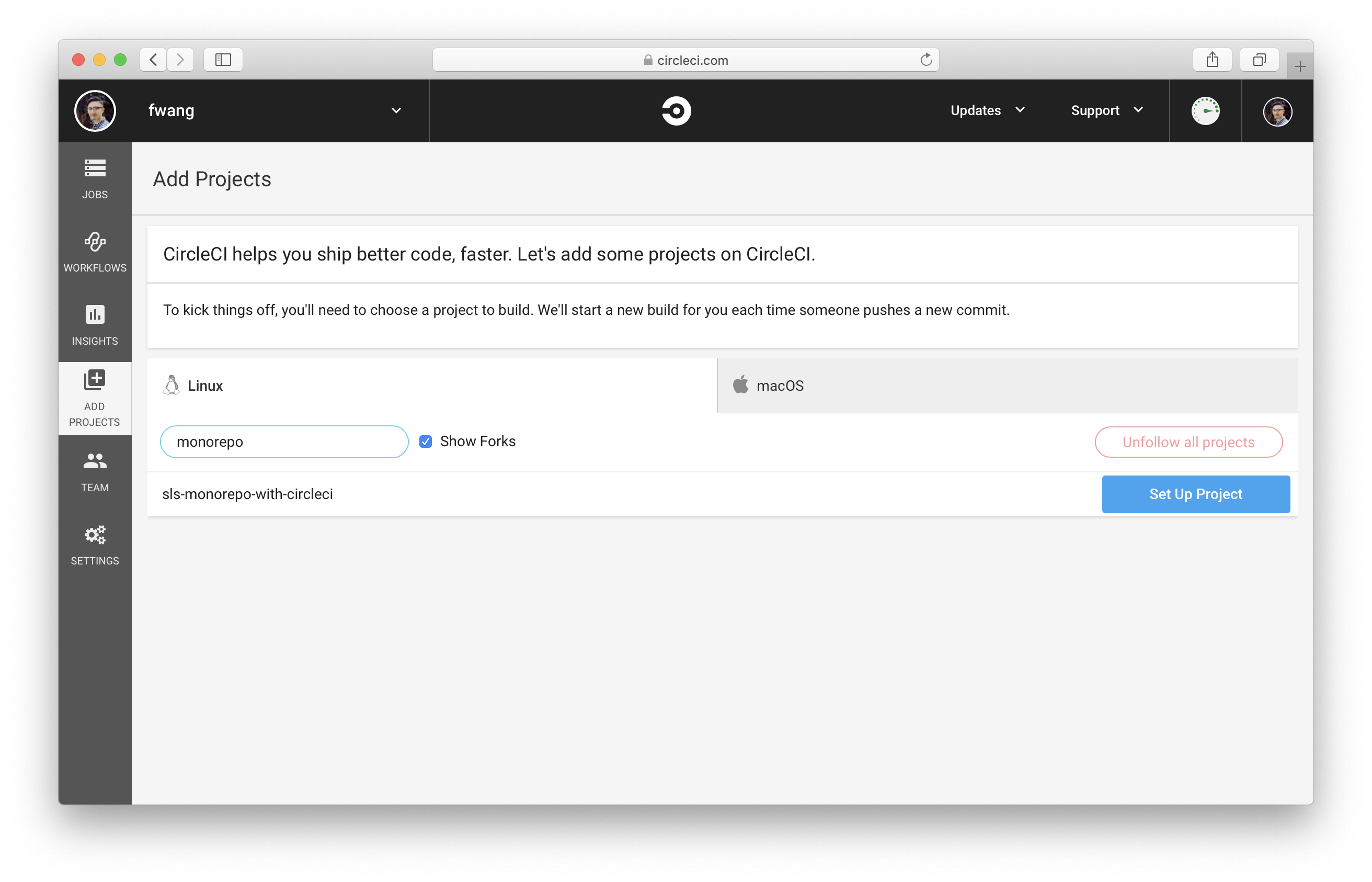
Select Linux as the Operating System, and Node as the Language. Go to step 5 and click on Start building.
Then click on WORKFLOWS in the left menu.
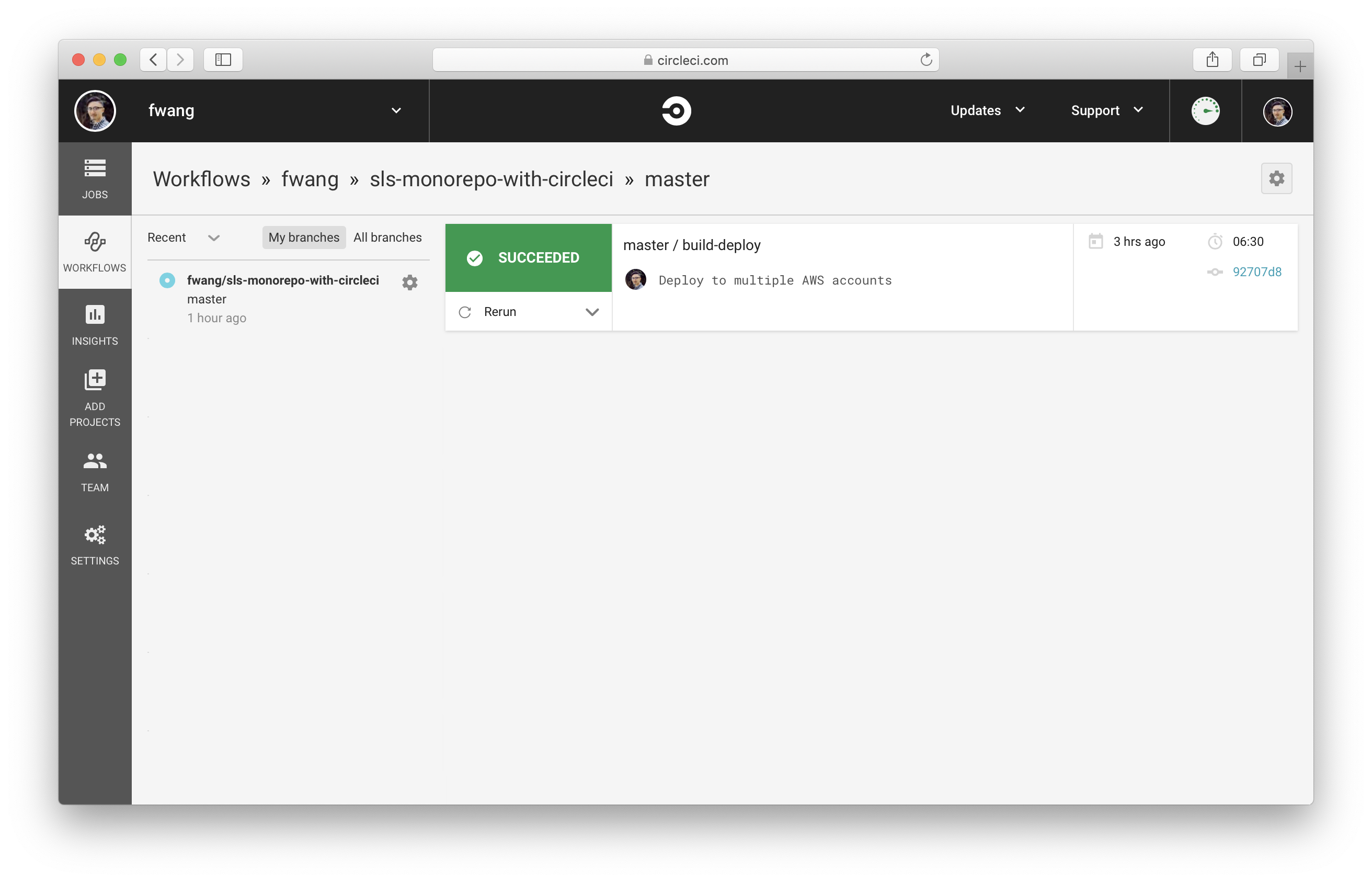
Click on the workflow, you will see the 3 jobs that are currently running.
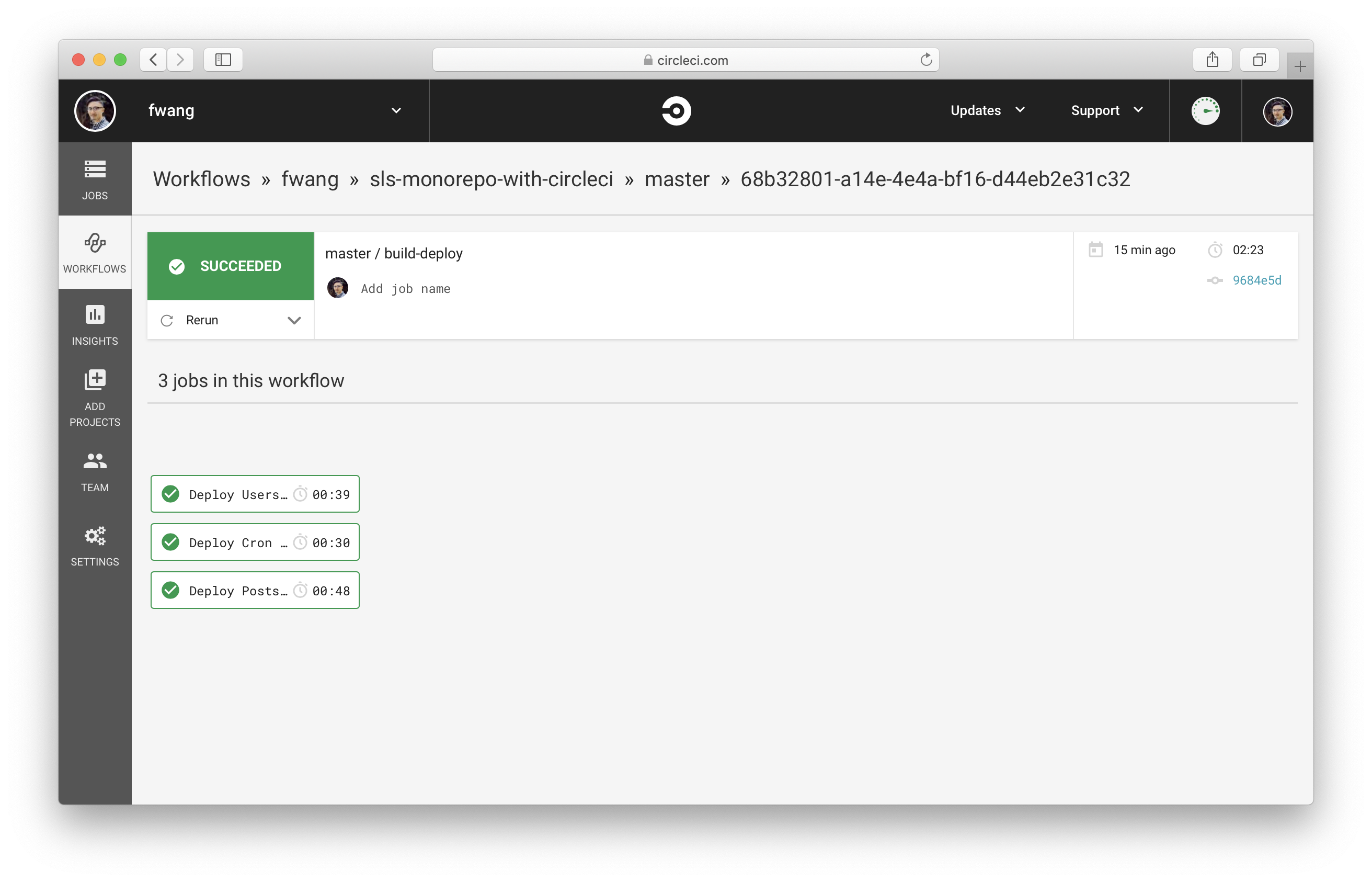
Click on a job. You will see the output for each of the steps. Scroll down to the Deploy application section, and you should see the output for the serverless deploy -s master command.
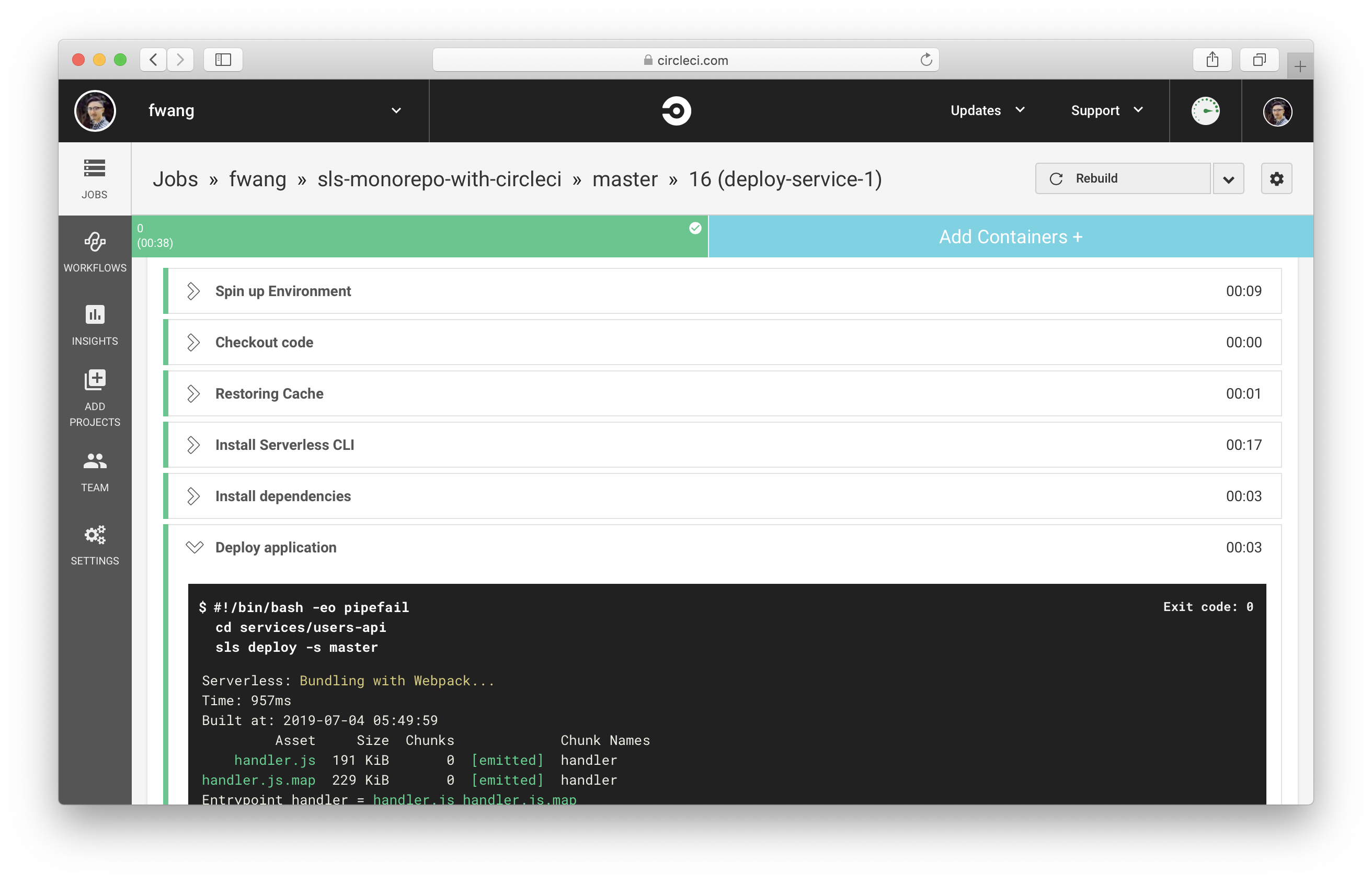
Now that we have the basics up and running, let’s look at how to deploy our app to multiple AWS accounts.
2. How to deploy to multiple AWS accounts
You might be curious as to why we would want to deploy to multiple AWS accounts. It’s a good practice to keep your development and production environments in separate accounts. By separating them completely, you can secure access to your production environment. This will reduce the likelihood of accidentally removing resources from it while developing.
To deploy to another account, repeat the earlier step of creating a Development context, and create a Production context with the AWS Access Key Id and Secret Access Key of your production AWS account.
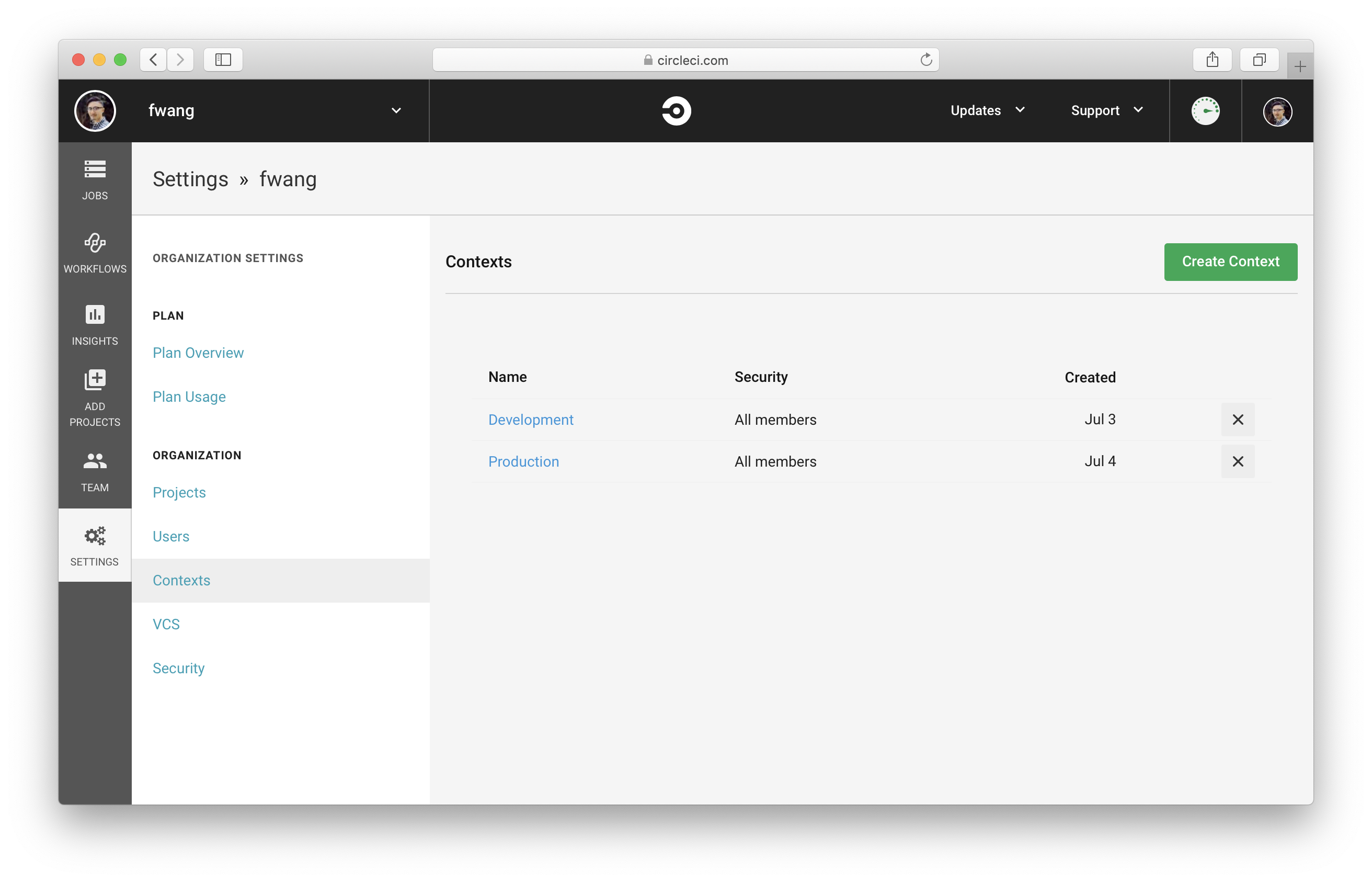
Go to your GitHub repo and open .circleci/config.yml. Replace it with the following:
version: 2.1
jobs:
deploy-service:
docker:
- image: circleci/node:8.10
parameters:
service_path:
type: string
stage_name:
type: string
steps:
- checkout
- restore_cache:
keys:
- dependencies-cache-{{ checksum "package-lock.json" }}-{{ checksum "<< parameters.service_path >>/package-lock.json" }}
- dependencies-cache
- run:
name: Install Serverless CLI
command: sudo npm i -g serverless
- run:
name: Install dependencies
command: |
npm install
cd << parameters.service_path >>
npm install
- run:
name: Deploy application
command: |
cd << parameters.service_path >>
serverless deploy -s << parameters.stage_name >>
- save_cache:
paths:
- node_modules
- << parameters.service_path >>/node_modules
key: dependencies-cache-{{ checksum "package-lock.json" }}-{{ checksum "<< parameters.service_path >>/package-lock.json" }}
workflows:
build-deploy:
jobs:
# non-master branches deploys to stage named by the branch
- deploy-service:
name: Deploy Users API
service_path: services/users-api
stage_name: ${CIRCLE_BRANCH}
context: Development
filters:
branches:
ignore: master
- deploy-service:
name: Deploy Posts API
service_path: services/posts-api
stage_name: ${CIRCLE_BRANCH}
context: Development
filters:
branches:
ignore: master
- deploy-service:
name: Deploy Cron Job
service_path: services/cron-job
stage_name: ${CIRCLE_BRANCH}
context: Development
filters:
branches:
ignore: master
# master branch deploys to the 'prod' stage
- deploy-service:
name: Deploy Users API
service_path: services/users-api
stage_name: prod
context: Production
filters:
branches:
only: master
- deploy-service:
name: Deploy Posts API
service_path: services/posts-api
stage_name: prod
context: Production
filters:
branches:
only: master
- deploy-service:
name: Deploy Cron Job
service_path: services/cron-job
stage_name: prod
context: Production
filters:
branches:
only: master
This does a couple of things:
- A Git push to the master branch will be deployed to the prod stage, instead of the stage with the branch name. It’ll also use the Production context.
- A Git push to all the other branches will be deployed to the stage with their branch name using the Development context.
Commit and push this change. This will trigger Circle to build the master branch again. This time deploying to your production account.
Next, let’s look at implementing the PR aspect of our Git workflow.
3. How to deploy in pull request workflow
A big advantage of using Serverless is how easy and cost effective it is to deploy many different versions (ie. stages) of your app. A great use case for this is to deploy a version of your app for each pull request to preview how the merged version would work, similar to the idea of Review Apps on Heroku.
Unfortunately, Circle does not support pull requests natively. It can be achieved with a little bit of bash scripting. Let’s look at how to set that up.
Go to your GitHub repo and open the .circleci/config.yml that we had created above. Replace it with the following:
version: 2.1
jobs:
deploy-service:
docker:
- image: circleci/node:8.10
parameters:
service_path:
type: string
stage_name:
type: string
steps:
- checkout
- run:
name: Check Pull Request
command: |
if [[ ! -z "$CIRCLE_PULL_REQUEST" ]]; then
# parse pr# from URL https://github.com/fwang/sls-monorepo-with-circleci/pull/1
PR_NUMBER=${CIRCLE_PULL_REQUEST##*/}
echo "export PR_NUMBER=$PR_NUMBER" >> $BASH_ENV
echo "Pull request #$PR_NUMBER"
fi
- run:
name: Merge Pull Request
command: |
if [[ ! -z "$PR_NUMBER" ]]; then
git fetch origin +refs/pull/$PR_NUMBER/merge
git checkout -qf FETCH_HEAD
fi
- restore_cache:
keys:
- dependencies-cache-{{ checksum "package-lock.json" }}-{{ checksum "<< parameters.service_path >>/package-lock.json" }}
- dependencies-cache
- run:
name: Install Serverless CLI
command: sudo npm i -g serverless
- run:
name: Install dependencies
command: |
npm install
cd << parameters.service_path >>
npm install
- run:
name: Deploy application
command: |
cd << parameters.service_path >>
if [[ ! -z "$PR_NUMBER" ]]; then
serverless deploy -s pr$PR_NUMBER
else
serverless deploy -s << parameters.stage_name >>
fi
- save_cache:
paths:
- node_modules
- << parameters.service_path >>/node_modules
key: dependencies-cache-{{ checksum "package-lock.json" }}-{{ checksum "<< parameters.service_path >>/package-lock.json" }}
workflows:
build-deploy:
jobs:
# non-master branches deploy to stage named by the branch
- deploy-service:
name: Deploy Users API
service_path: services/users-api
stage_name: ${CIRCLE_BRANCH}
context: Development
filters:
branches:
ignore: master
- deploy-service:
name: Deploy Posts API
service_path: services/posts-api
stage_name: ${CIRCLE_BRANCH}
context: Development
filters:
branches:
ignore: master
- deploy-service:
name: Deploy Cron Job
service_path: services/cron-job
stage_name: ${CIRCLE_BRANCH}
context: Development
filters:
branches:
ignore: master
# master branch deploy to the 'prod' stage
- deploy-service:
name: Deploy Users API
service_path: services/users-api
stage_name: prod
context: Production
filters:
branches:
only: master
- deploy-service:
name: Deploy Posts API
service_path: services/posts-api
stage_name: prod
context: Production
filters:
branches:
only: master
- deploy-service:
name: Deploy Cron Job
service_path: services/cron-job
stage_name: prod
context: Production
filters:
branches:
only: master
Let’s go over the changes we’ve made.
- We added a Check Pull Request step. We check the built-in environment variable $CIRCLE_PULL_REQUEST to decide if the current branch belongs to a pull request. If it does, then we set an environment variable called $PR_NUMBER with the pull request id.
- We also added a Merge Pull Request step, where we checkout the merged version of code from GitHub.
- We then change the Deploy application step to deploy to the name the stage pr# when deploying a pull request.
Commit these changes to .circleci/config.yml.
Next, go to GitHub and create a pull request to the master branch. This will trigger Circle to deployed the merged code with stage name pr1 to your development account.
4. How to clean up unused branches and closed pull requests
After a feature branch is deleted, or a pull request closed, you want to clean up the resources in your AWS account. Circle does not have triggers for these events on GitHub. If you have the credentials for your AWS account, you can perhaps remove the resources by going into each service directory on your local machine and running serverless remove. This step is both cumbersome and not ideal.
To get around this limitation, we’ll use a little trick. We’ll tell Circle to remove a stage (instead of deploying to one) if it sees a Git tag called rm-stage-STAGE_NAME.
To do this, go to your GitHub repo and open .circleci/config.yml that we created above. Replace it with the following:
version: 2.1
jobs:
deploy-service:
docker:
- image: circleci/node:8.10
parameters:
service_path:
type: string
stage_name:
type: string
steps:
- checkout
- run:
name: Check Pull Request
command: |
if [[ ! -z "$CIRCLE_PULL_REQUEST" ]]; then
# parse pr# from URL https://github.com/fwang/sls-monorepo-with-circleci/pull/1
PR_NUMBER=${CIRCLE_PULL_REQUEST##*/}
echo "export PR_NUMBER=$PR_NUMBER" >> $BASH_ENV
echo "Pull request #$PR_NUMBER"
fi
- run:
name: Merge Pull Request
command: |
if [[ ! -z "$PR_NUMBER" ]]; then
git fetch origin +refs/pull/$PR_NUMBER/merge
git checkout -qf FETCH_HEAD
fi
- restore_cache:
keys:
- dependencies-cache-{{ checksum "package-lock.json" }}-{{ checksum "<< parameters.service_path >>/package-lock.json" }}
- dependencies-cache
- run:
name: Install Serverless CLI
command: sudo npm i -g serverless
- run:
name: Install dependencies
command: |
npm install
cd << parameters.service_path >>
npm install
- run:
name: Deploy application
command: |
cd << parameters.service_path >>
if [[ ! -z "$PR_NUMBER" ]]; then
serverless deploy -s pr$PR_NUMBER
else
serverless deploy -s << parameters.stage_name >>
fi
- save_cache:
paths:
- node_modules
- << parameters.service_path >>/node_modules
key: dependencies-cache-{{ checksum "package-lock.json" }}-{{ checksum "<< parameters.service_path >>/package-lock.json" }}
remove-service:
docker:
- image: circleci/node:8.10
parameters:
service_path:
type: string
stage_name:
type: string
steps:
- checkout
- restore_cache:
keys:
- dependencies-cache-{{ checksum "package-lock.json" }}-{{ checksum "<< parameters.service_path >>/package-lock.json" }}
- dependencies-cache
- run:
name: Install Serverless CLI
command: sudo npm i -g serverless
- run:
name: Install dependencies
command: |
npm install
cd << parameters.service_path >>
npm install
- run:
name: Remove application
command: |
cd << parameters.service_path >>
# parse stage name from TAG rm-stage-pr1
serverless remove -s << parameters.stage_name >>
- save_cache:
paths:
- node_modules
- << parameters.service_path >>/node_modules
key: dependencies-cache-{{ checksum "package-lock.json" }}-{{ checksum "<< parameters.service_path >>/package-lock.json" }}
workflows:
build-deploy:
jobs:
# non-master branches deploy to stage named by the branch
- deploy-service:
name: Deploy Users API
service_path: services/users-api
stage_name: ${CIRCLE_BRANCH}
context: Development
filters:
branches:
ignore: master
- deploy-service:
name: Deploy Posts API
service_path: services/posts-api
stage_name: ${CIRCLE_BRANCH}
context: Development
filters:
branches:
ignore: master
- deploy-service:
name: Deploy Cron Job
service_path: services/cron-job
stage_name: ${CIRCLE_BRANCH}
context: Development
filters:
branches:
ignore: master
# master branch deploy to the 'prod' stage
- deploy-service:
name: Deploy Users API
service_path: services/users-api
stage_name: prod
context: Production
filters:
branches:
only: master
- deploy-service:
name: Deploy Posts API
service_path: services/posts-api
stage_name: prod
context: Production
filters:
branches:
only: master
- deploy-service:
name: Deploy Cron Job
service_path: services/cron-job
stage_name: prod
context: Production
filters:
branches:
only: master
# remove non-production stages
- remove-service:
name: Remove Users API
service_path: services/users-api
stage_name: ${CIRCLE_TAG:9}
context: Development
filters:
tags:
only: /^rm-stage-.*/
branches:
ignore: /.*/
- remove-service:
name: Remove Posts API
service_path: services/posts-api
stage_name: ${CIRCLE_TAG:9}
context: Development
filters:
tags:
only: /^rm-stage-.*/
branches:
ignore: /.*/
- remove-service:
name: Remove Cron Job
service_path: services/cron-job
stage_name: ${CIRCLE_TAG:9}
context: Development
filters:
tags:
only: /^rm-stage-.*/
branches:
ignore: /.*/
Let’s look at what we changed here:
- We created a new job called remove-service. It’s similar to our deploy-service job, except it runs
serverless remove. It assumes the name of the tag is of the formatrm-stage-STAGE_NAME. It parses for the stage name after the 2nd hyphen. - We also set the workflow to run the remove-service job for each of our services.
To test this, try tagging the pull request branch before you close the PR.
$ git tag rm-stage-pr1
$ git push --tags
You’ll notice that the pr1 stage will be removed from your development account.
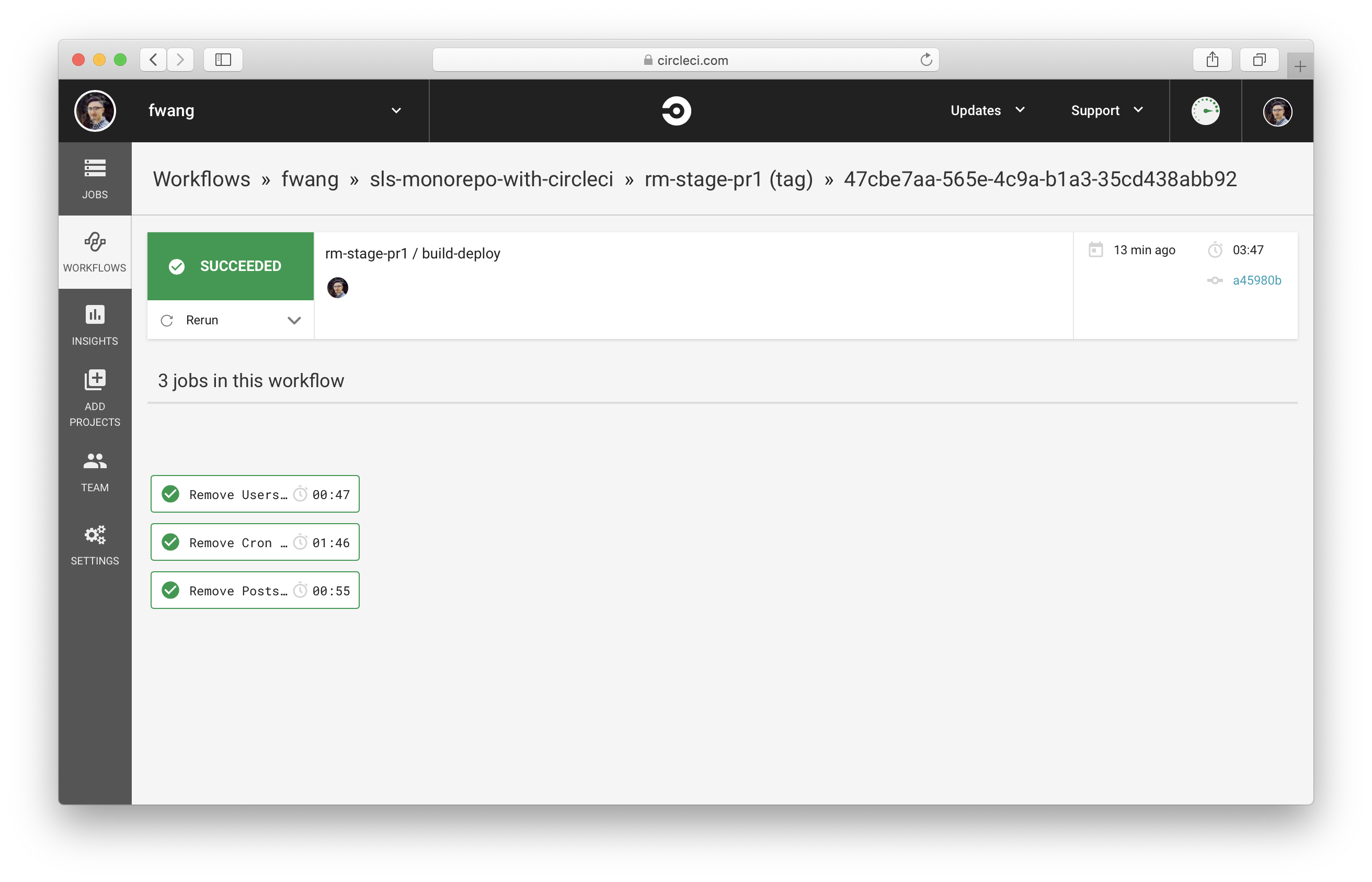
And that’s it! Let’s wrap things up next.
Next steps
It took us a few steps but we now have a fully-functional CI/CD pipeline for our monorepo Serverless app. It supports a PR based workflow and even cleans up once a PR is merged. The repo used in this guide is available here with the complete CircleCI configs.
Some helpful next steps would be to auto-create custom domains for your API endpoints, send out Slack or email notifications, generate CloudFormation change sets and add a manual confirmation step when pushing to production, etc. You also might want to design your workflow to accommodate for any dependencies your services might have. These are cases where the output from one service is used in another.
Finally, if you are not familiar with Seed, it’s worth noting that it’ll do all of the above for you out of the box! And you don’t need to write up a build spec or do any scripting.
Do your Serverless deployments take too long? Incremental deploys in Seed can speed it up 100x!
Learn More